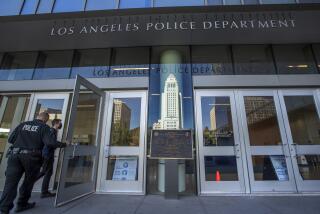Man shot by LAPD officers who mistook cellphone for gun wins $2.35 million at trial
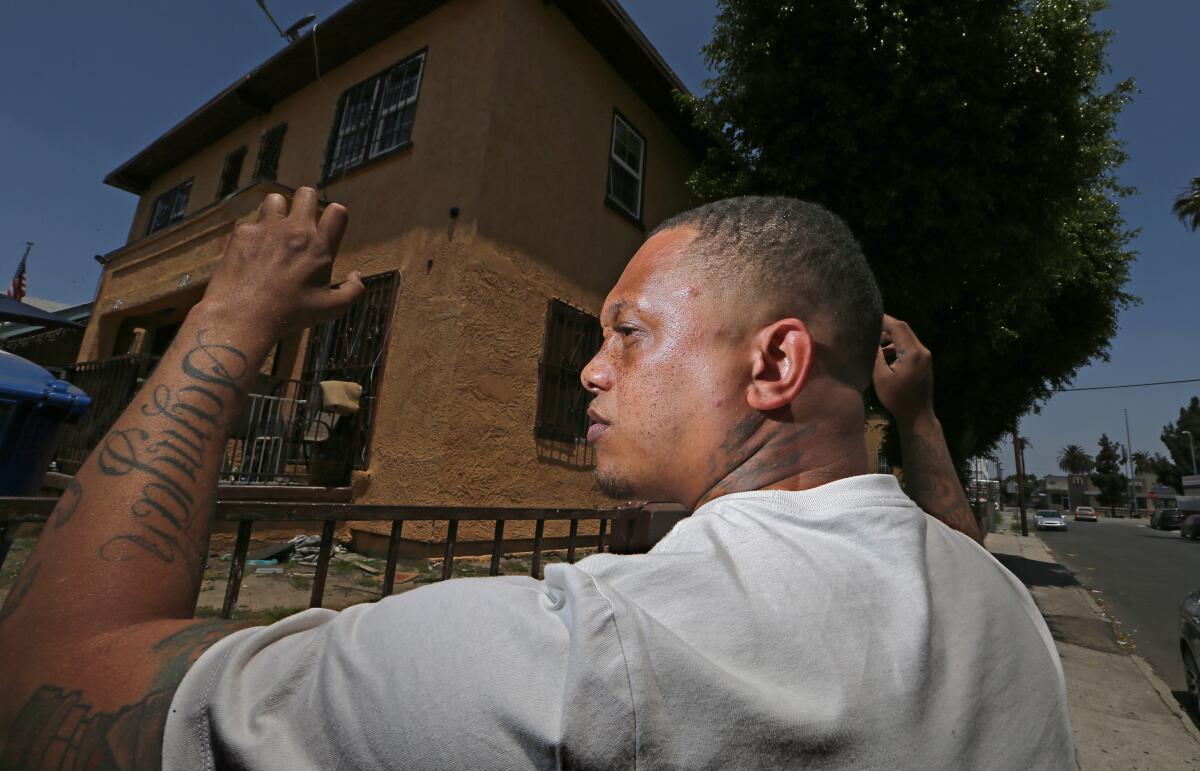
- Share via
Dexter White’s chest still tightens when he sees the photo on Instagram of his crumpled body, moments after a group of Los Angeles police officers shot him after mistaking his cellphone for a gun.
He had pulled out the phone in confusion as officers surrounded him as he walked to the corner store, responding to what turned out to be a false report of domestic violence one afternoon more than five years ago.
One of the officers thought White might have a gun, prompting him and several colleagues to start shooting. Bullets ripped into his legs and shoulder as he fell to the pavement — but he survived.
His shooting, around the corner from his South L.A. apartment building, was one of at least 38 in the last five years in which LAPD officers opened fire on someone who ended up being unarmed, according to a Times review of nearly 200 police shootings since 2018.
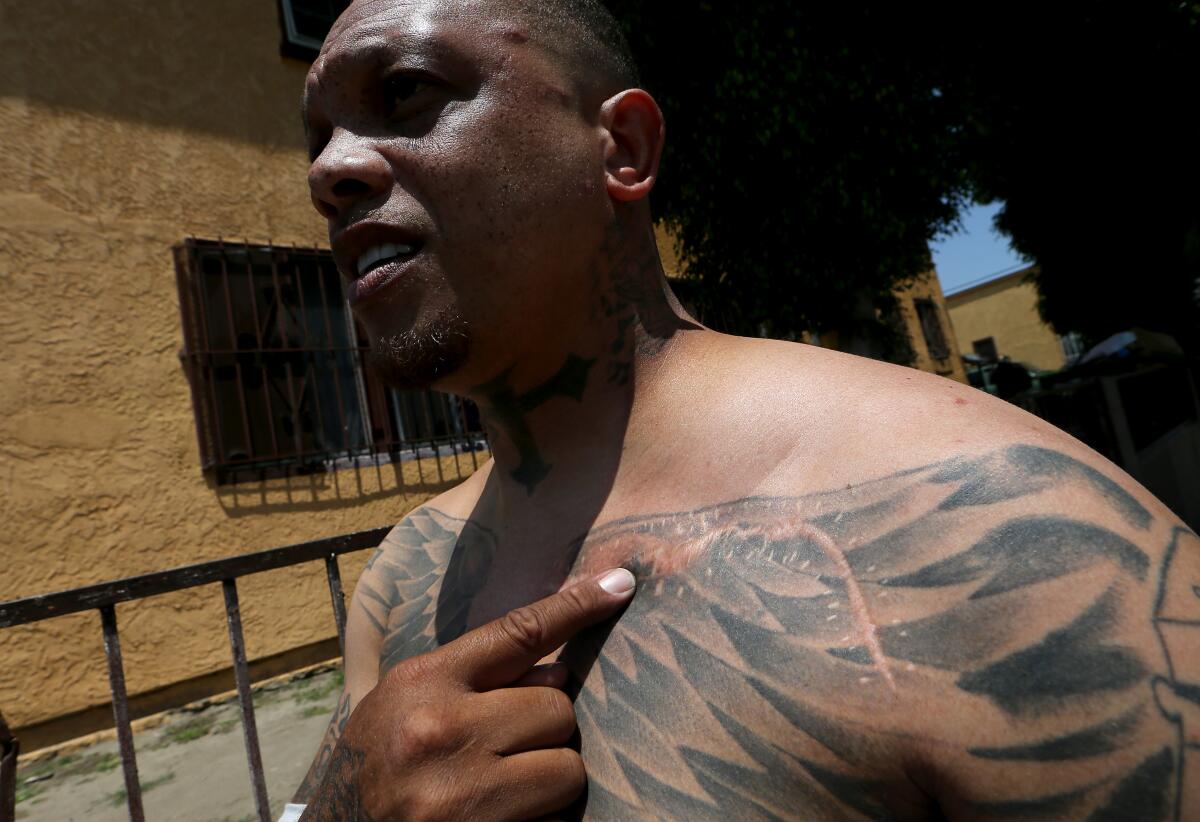
The near-death experience left White traumatized and prone to bouts of fear, anxiety and anger.
“I’ve broken down multiple times,” White said. He no longer drives by himself, out of fear of being pulled over while alone, he said.
Since the shooting, he has been stopped several times while riding in the car with his aunt Alexis Banks, each time explaining to officers what happened to him so they don’t misinterpret his jitters.
In some LAPD shootings since 2018, the person hit was carrying a plastic replica pistol or butane lighter that resembled a firearm, cases that fit the state attorney general’s definition of unarmed. In several other cases, officers shot at someone after they discarded their weapon.
At times, officers have hit innocent bystanders, drawing criticism from some city leaders, activists and residents that officers are still too quick to use lethal force without considering options to resolve a situation. Two years ago, an LAPD officer killed 14-year-old Valentina Orellana Peralta when he shot at an assault suspect in a North Hollywood store. Like other shooting survivors and relatives of those killed by LAPD officers, the teen’s family sued the city, alleging that the officer who fired the fatal bullet violated her rights. The case is pending.
White filed his own lawsuit challenging the actions that led to him being shot in 2018.
The first officer to shoot opened fire so quickly after arriving on the scene that he couldn’t even put his police cruiser in park, White’s lawsuit said. His gunfire prompted other officers to start shooting in the belief they were under fire, which the lawsuit described as a clear case of so-called contagious fire.
Last month, a federal jury ruled in White’s favor, finding that LAPD Officer Rodolfo Sarmiento had violated his constitutional rights in the January 2018 shooting while he was unarmed. White was awarded $2.35 million in damages.
In his closing arguments, George Mgdesyan, White’s attorney, said that his client was not being aggressive and made no moves toward the officers that could be mistaken for an attack. If anything, Mgdesyan said, White was fearful, as many Black men would be upon encountering a group of officers with their guns drawn, he said.
Mgdesyan argued that while some officers at the scene tried to de-escalate the situation, Sarmiento seemed primed for a confrontation, driving there with his gun drawn and jumping out of a still-rolling squad car “like it’s the wild, wild West.”
Among other missteps, Mgdesyan said, several officers involved failed to activate their body-worn cameras. And none of them recalled White taking a shooting stance or seeing the barrel of a gun while being interviewed shortly after the shooting; they mentioned those details only months later at their depositions, the attorney said.
A 911 caller had mistakenly reported that White might be armed with a knife, but Mgdesyan said that did not warrant lethal force. “If the police mentality is that anytime I pull somebody over it can escalate to a shooting, then that would justify shooting every time,” he said.
Geoffrey Plowden, an attorney for the officers, said they believed they might be facing an armed suspect who had just stabbed a woman. “We’re not talking about … jaywalking,” he said.
Plowden said the encounter might have ended differently if White had obeyed police commands. Instead, he said, White forced officers to react quickly when he crossed his arms, a move that suggested defiance, not confusion, and began digging into his pockets.
As the defense played video of the encounter, several of White’s supporters walked out, sobbing. Others turned away from the large TV screen. White bowed his head as the sound of the officers’ gunfire filled the courtroom, his face scrunched in a grimace.
“We’re not here because the officers shot him, it’s because he forced the officers to shoot him because he didn’t obey their commands,” Plowden said.
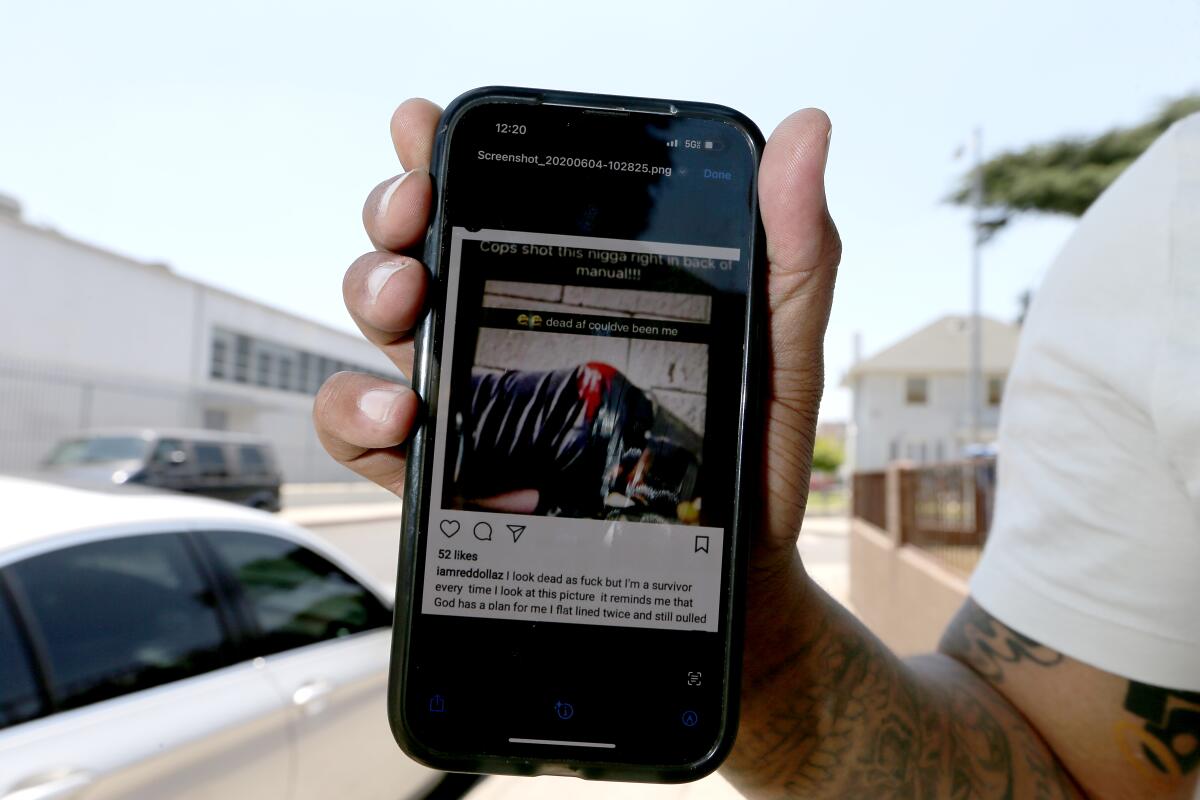
White said he walked to the store to buy cigarettes and clear his head after getting into a heated argument with the teenage daughter of a woman he was romantically involved with. He wasn’t aware at the time, but the daughter had gone next door and called 911 to say someone had been stabbed — a fib that she later retracted, White said.
He heard the helicopter buzzing overhead, but didn’t realize it was there for him. When the first two officers showed up, they screamed at him to drop his weapon and to get on the ground. He froze. “I stopped and I was confused because I didn’t know what was going on,” White said, saying other arriving officers made no efforts to de-escalate the situation. “Soon as I turned my back, I heard gunshots and hit the ground.”
The jury cleared the other two officers who fired their weapons, Davin Aquino and James Quinata.
An after-action report by the inspector general’s office was critical of certain aspects of the officers’ tactics, singling out Sarmiento for drawing his weapon while driving to the scene and jumping out of a still-moving vehicle, which placed him “at a tactical disadvantage.”
The report concluded that the officers’ 19 shots were justified given the “totality of the circumstances,” contending that Sarmiento and others reasonably reacted so quickly based on the belief that White was pointing a gun in their direction.
While the department doesn’t offer any specific training on identifying whether a person is carrying a gun, officers are generally taught to focus on a person’s hands during an encounter, keying in on visual cues like someone reaching for their waistband, according to LAPD Sgt. Tom Willers, assistant officer in charge of the department’s tactics unit.
Willers said officers are trained to consider de-escalation first, using space and cover to slow down encounters. At the same time, he said, they are taught to always be vigilant since seemingly innocuous items can be weapons: “We’re talking about cane guns, we’re talking about wallet guns, we’re talking about guns that are created to look like cellphones.”
Such training occurs first at the Police Academy and every year officers are on the job, he said.
Despite public perception, he said, police shootings are statistically rare. Of 2,300 uses of force by LAPD in 2018, only 26 involved firearms, and the instances when officers shot an unarmed person are even more infrequent.
Officers are also put through the department’s next-gen virtual reality simulator, which Willers said drops them into scenarios meant to replicate the fast-moving nature of police work to see how they will react, all while tracking their heart rate and eye movements. Afterward, officers are debriefed, with trainers pointing out areas of improvement.
After prevailing in his trial, White said the money he was awarded will help with a mountain of medical bills: $150,000 for reconstructive surgery on his clavicle, $25,000 to fix his clawed hands; and $50,000 to replace his hip, where a bullet remains lodged. Doctors have said he may always walk with a limp. Perhaps his biggest lament is that he can’t teach his son how to shoot hoops because his hand won’t open wide enough to dribble a basketball.
He scoffed at the allegation — raised by officers at the trial — that he was trying to commit “suicide-by-cop.” Why would he do that, White asked, when he was days away from signing a deal with a record label. The deal fell apart as he lay in the hospital for months, recovering.
He said he struggles to put on a strong face in front of his kids, ages 5 through 15, who have “very vivid” memories of almost losing their father.
“They don’t want him to leave home because they don’t want anything to happen to him,” his aunt said. “They’re traumatized.”
On a recent afternoon, White’s eyes welled with tears as he ticked off his lingering injuries. The last few years have been hell, he said. Nerve damage left him with such limited range in his hands that he can’t make a closed fist.
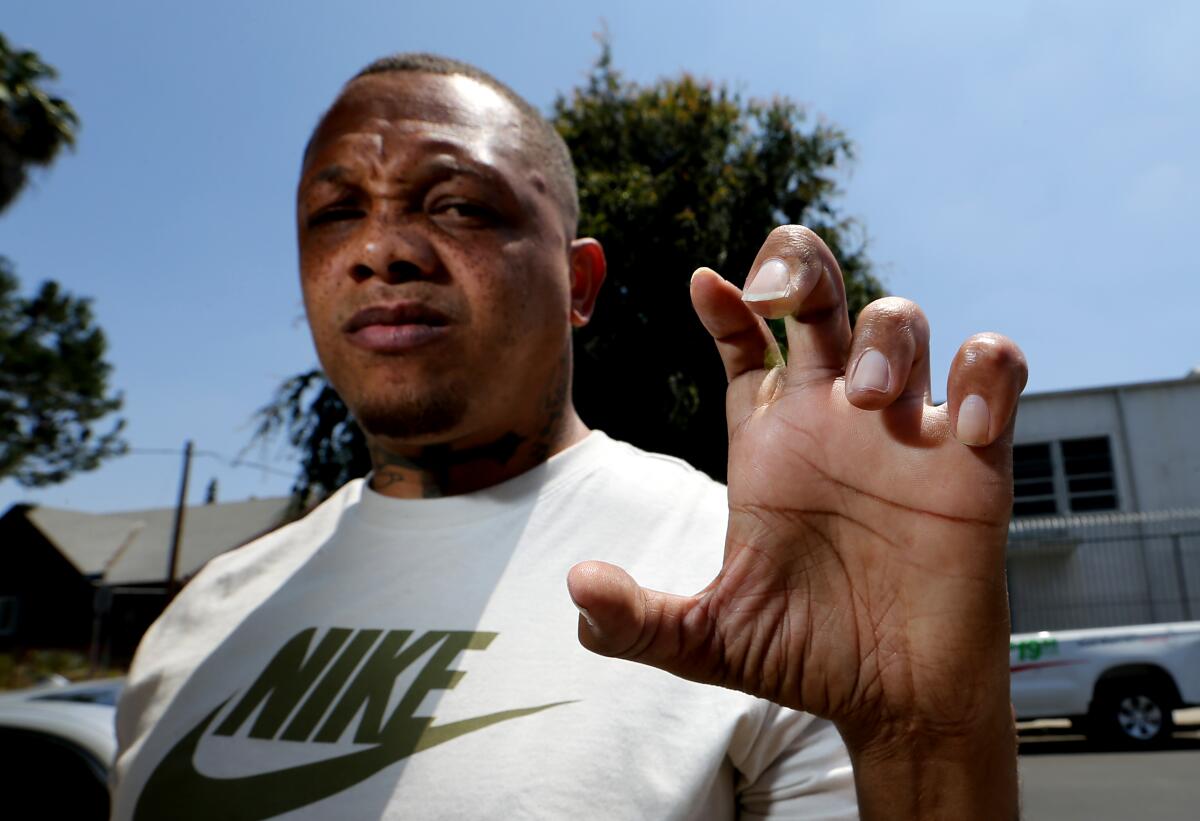
White declined to stay on prescribed painkillers, because he didn’t want to get addicted. Instead, he toughs out everyday tasks. “Even putting on socks is hard,” he said.
He still suffers from regular panic attacks, including once during church when he didn’t realize his pastor had invited several officers to speak to the congregation.
“My whole body just freezes up and starts trembling and stuff,” he said. He felt an attack coming on after someone sent a photo of him that was circulating on Instagram. A student at the high school across the street took the photo of White as he lay motionless on the sidewalk after being shot. The caption read: “Cops shot this [Black man] in back of manual [Arts High School]!!!” and “dead af couldve been me,” with two crying face emojis.
“It kind of shocked me, because I looked dead and it really set me back a little bit,” he said. “It kind of scared me a little bit that I even experienced that, and it all came back to me at once.”
More to Read
Sign up for Essential California
The most important California stories and recommendations in your inbox every morning.
You may occasionally receive promotional content from the Los Angeles Times.
